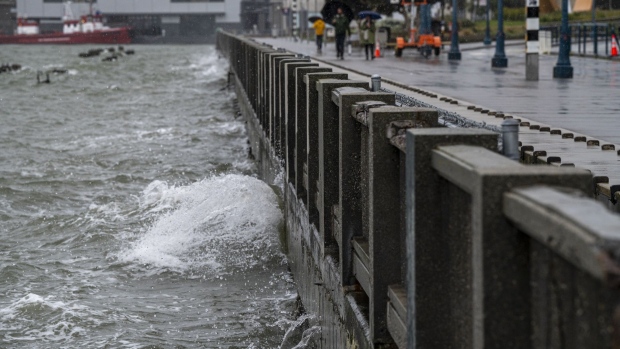Mar 10, 2023
California’s Newsom Seeks Federal Disaster Declaration as Rivers Swell
, Bloomberg News

(Bloomberg) -- A deadly rainstorm thrashing California has forced homeowners to flee rising rivers, closed roads, caused at least two deaths and prompted President Joe Biden to declare a state of emergency.
Intense wind and rain toppled trees, crushing cars and pulling down power lines. The first of two back-to-back storms — atmospheric rivers that draw warm, moist air from far out over the ocean — struck as California struggles to recover from months of extreme weather. The drenching rains threaten to melt lingering snow from a February blizzard that buried mountain towns, elevating risks of overflowing rivers.
Some 9,400 Californians were forced to flee their homes in flood-prone areas as of midday, Nancy Ward, director of the state’s Office of Emergency Services, told reporters in a Friday briefing. Many more people are under evacuation warnings. Two deaths have been blamed on the storm already, she said, without elaborating.
“We want to remind Californians as always that they have a responsibility to prepare for themselves and to ensure that they’re safe,” Ward said. “If you’re told to evacuate, please do so as soon as possible.”
The state has opened 15 shelters in nine counties to take in anyone forced to leave their homes, Ward said. The California Department of Transportation deployed 4,000 workers on 12-hour shifts to clear roadways. Biden’s disaster declaration will speed federal aid to the hardest-hit counties.
In Santa Cruz County, officials temporarily evacuated the town of Felton as the San Lorenzo River, which flooded in January, overflowed its banks. A raging creek washed away Main Street in the nearby town of Soquel, while mudslides closed State Route 152, a major road through the area.
Fierce winds toppled trees, including a towering eucalyptus in San Francisco’s Golden Gate Park that crushed several cars. Gusts also knocked out power lines, leaving more than 53,000 homes and businesses without electricity, according to PowerOutage.us.
The California Independent System Operator, which runs most of the state’s power grid, declared a storm-related transmission emergency in the Humboldt area along the north coast.
In mountains still locked in by heavy snow, water pooled on exit ramps and lanes of Interstate 80, according to Scott Rowe, a National Weather Service meteorologist in Sacramento. Rock slides closed parts of the iconic Route 1, according to the state transportation department. Water temporarily blocked a major freeway in Oakland and another in Gilroy, south of San Jose.
In Oakland, one person died overnight when a warehouse roof fell in during the storm, although the city’s fire department said Friday the exact cause of the collapse was under investigation.
Onslaught of storms
As California grapples with the dangerous storm, it’s also taking steps to capture more snowpack and runoff that otherwise rolls into the ocean. That would help ease the drought that has ravaged the state in recent years.
On Friday, Governor Gavin Newsom issued an executive order that’s intended to streamline the process for diverting floodwaters into recharging groundwater supplies. A key reason: underground aquifers can take years to replenish.
But for California’s agriculture industry, the focus is on the latest in a series of storms that have pummeled the state. George Brightman, who cares for more than 400 cows across about 12,000 acres in northern California, has struggled to get to his animals for weeks due to bad weather.
“This thing’s lasted three weeks, and all the heavy rains before that and the cold,” he said of the recent weather. “It’s just been a really, really tough year.”
--With assistance from Dana Hull and Elizabeth Elkin.
(Updates with governor’s executive order in the 12th paragraph. A previous version corrected the spelling of town’s name in sixth paragraph.)
©2023 Bloomberg L.P.





